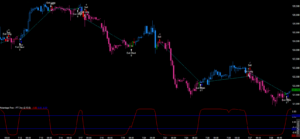Benefits of coding and testing your ideas.
Today’s investing is getting more and more competitive. Traders from around the globe have access to pretty much all markets. They all seek to profit from financial markets, and since futures markets are sum zero game some of them must fail to keep the market going.
New or experienced trader have only three options: full discretionary trading, full automated trading or somewhere in between.
Discretionary Trading
Going full discretionary has one large benefit. You don’t have to code anything. But it also comes as the largest drawback. Without coding there is no way to test an idea to see how it would perform in the past. The solution to this problem is passage of time. Statisticians say that the minimal sample should contain at least 30 elements – in this case trades. This is not that hard to do. Trading only once a week it will take little more than six months. But it is very hard to get the full market cycle which consist of bull and bear market. So we need more time. Finally, after months or years of real trading some valuable statistics are accessible. And finally we see if we know what we are doing.
Automated Trading
Totally different solution is to go partially-automated or 100% automated trading. TradeStation strategies can be built around very large set of existing indicators, plus the existing or newly created indicators can be used in countless ways to build a strategy. By doing that testing the algorithm can give answers to 4 most important questions:
What instrument to trade? Which position to take – long, short or flat (yes – being out of market is a position)? When to enter the trade? When to exit the trade? And what TradeStation indicators really work?

What to Trade
Let’s start with what to trade. TradeStation offers variety of radar screens and scanners that, based on given conditions, give a list of stocks/futures that fulfill these conditions. It can be new high/low, oscillator crossing certain level or any other condition that can be logically described. At this point it is hard to go with full automation, because sometimes list of instruments can be very long. Therefore, discretionary approach will be most common in selection process. Of course, it can be fully automated, but it would require large amount of capital, to take all trades that might occur. Another element of “what” is a time frame. Scalping on monthly chart is counterproductive. Same as trying to apply fundamental portfolio management on 1-minute chart. So the trader, doing it discretionally will probably choose optimal time frame. Not optimal for the profits, but optimal for trader – her/his risk aversion and lifestyle, because not everyone wants to stare at computer screen 12 hours a day.
Second thing is position or direction of trade we would like to place. In TradeStation, strategies can be designed to go with or against the trend. There is plenty of ways to establish the trend, but much fewer tools to establish if market is trending or in sideways mode. This opens lots of opportunities for the future, since it will tell a trader when to be flat.
Smoothly, we are facing the third challenge – position opening. Trading with the trend trader will probably seek an ultimate confirmation of trend which is new high or low. On the other hand, going with mean reversion strategy trader will look for oversold or overbought condition hoping for the price to revert to the mean. Depending on which market we are in, which type of trading we do (with or against the trend) and why we opened the position the last but definitely not the least aspect of trading comes in: closing the position. Apart from that the position should be closed as soon as it reaches predetermined stop-loss level, we have two options (or combination of two). Trend following traders will probably choose to use trailing stop hoping that it will get the most out of the move. Other way is profit taking at the predetermined level or if specific signal occurs.
How to Take the First Step
Most of the times automated trading is the combination of all mentioned factors. All you have to do is start by choosing from various, free tradestation indicators, radar screens, scanners or even fully automated strategies. Now, take the first step!
Leave a Reply
You must be logged in to post a comment.